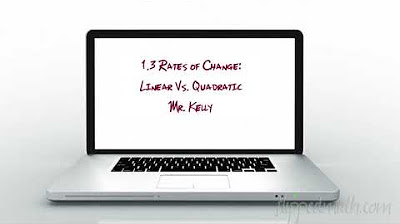How to Find the Surface Area of a Rectangular Prism | Math with Mr. J
Summary
TLDRIn this tutorial, Mr. J explains how to calculate the surface area of a rectangular prism. He walks through the step-by-step process of finding the area of each face (front, back, right, left, top, and bottom) and then adding them together. Using a formula that multiplies each face's area by 2 (since opposite faces are identical), Mr. J demonstrates how to calculate the total surface area. The video includes practical examples with clear visuals to ensure viewers understand how to apply the formula and solve similar problems on their own.
Takeaways
- 😀 Surface area refers to the total area of the outside layer of a 3D figure.
- 😀 A rectangular prism has six faces, and to find the surface area, the areas of each face must be calculated and added together.
- 😀 The formula for the surface area of a rectangular prism is: Surface Area = 2 * (Front or Back) + 2 * (Right or Left) + 2 * (Top or Bottom).
- 😀 Each face (front/back, right/left, top/bottom) comes in pairs, so you only need to find the area of one face in each pair and then multiply by 2.
- 😀 The area of the front or back is calculated as length * width, for example, 6 * 2 = 12 square inches.
- 😀 For the right or left, the area is found by multiplying length * width (e.g., 3 * 2 = 6 square inches).
- 😀 The area of the top or bottom is also found by multiplying length * width, such as 6 * 3 = 18 square inches.
- 😀 The net of a rectangular prism can help visualize the areas of the different faces, showing them in 2D form.
- 😀 After calculating the area of all faces, the surface areas are summed: 24 (front/back) + 12 (right/left) + 36 (top/bottom).
- 😀 The final surface area of the rectangular prism is 72 square inches, which is the sum of all the face areas combined.
Q & A
What is surface area in the context of a 3D figure?
-Surface area is the total area of the outside part or layer of a 3D figure.
How many faces does a rectangular prism have?
-A rectangular prism has six faces.
What is the formula for finding the surface area of a rectangular prism?
-The formula is: Surface area = 2 × (front/back area) + 2 × (right/left area) + 2 × (top/bottom area).
Why is each face multiplied by 2 in the surface area formula?
-Each face is multiplied by 2 because opposite faces of a rectangular prism are identical in size.
What is the area of the front face of the rectangular prism in the example?
-The area of the front face is 12 square inches (6 × 2 = 12).
How do we calculate the area of the right or left face of the rectangular prism?
-The area of the right or left face is calculated as length × width, in this case 3 × 2 = 6 square inches.
What is the area of the top or bottom face in the example?
-The area of the top or bottom face is 18 square inches (6 × 3 = 18).
What do we get when we multiply 2 times the area of the top and bottom faces?
-Multiplying 2 times the area of the top and bottom faces (2 × 18) gives 36 square inches.
What is the total surface area of the rectangular prism in the example?
-The total surface area is 72 square inches, which is the sum of all the areas of the faces: 24 (front/back) + 12 (right/left) + 36 (top/bottom).
How does using a net of the rectangular prism help in visualizing the surface area?
-The net shows all the faces unfolded, which helps in visualizing the areas and understanding how they contribute to the total surface area.
Outlines

此内容仅限付费用户访问。 请升级后访问。
立即升级Mindmap

此内容仅限付费用户访问。 请升级后访问。
立即升级Keywords

此内容仅限付费用户访问。 请升级后访问。
立即升级Highlights

此内容仅限付费用户访问。 请升级后访问。
立即升级Transcripts

此内容仅限付费用户访问。 请升级后访问。
立即升级浏览更多相关视频

Motion Characteristics of a Projectile

AP Precalculus – 1.3 Rates of Change Linear and Quadratic Functions

CARA MUDAH BEDAIN THEY, THEY’RE, THEIR, DAN THERE - Kampung Inggris LC | Teatu

Create checkerboard pattern in Photoshop tutorial how to

How to Add, Subtract, Multiply, and Divide Decimals | A Review of Decimals | Math with Mr. J

(BOCORAN) SOAL TES MASUK SMP/MTs‼️PART 1
5.0 / 5 (0 votes)
